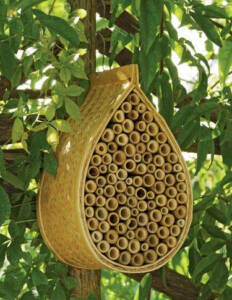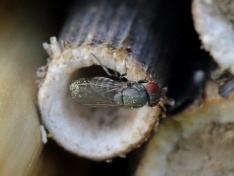Mason bees are a gardeners best friend and one of natures gentlest spring pollinators. As gardeners we appreciate the significant role of our tiny backyard Mason bee friends. They are one the few reliable early pollinators for farmers and gardeners before the honeybees. Many of us maintain cute little houses to protect and raise them, like this one.
This post may contain Affiliate links. I only share products I like or use myself. If you click on those links I may get a small commission at no extra cost to you. It helps keep this blog going. Full Disclosure Here:
They are under threat here in the Pacific NW by the parasitic Houdini fly.
The Houdini fly is a “kleptoparasite”. This parasitic fly doesn’t directly attack our Mason bees, instead it lays its eggs on the pollen meant for the mason bee brood. The Houdini fly maggots hatch out and consume the pollen, leaving the mason bee babies to starve.
Houdini flies have established themselves in the PNW and probably can’t be eliminated. However, there are simple steps to manage the pest and greatly reduce their numbers without any pesticide use. If you or anyone you know hosts mason bees, please spread the word to help one of our most important native pollinators.
Here’s a link to a Houdini fly alert that you can download and print.
Do you have backyard mason bee houses? Have you noticed the Houdini fly? I’d love to hear from you.
Thank you in advance for spreading the word to other gardeners. Happy Gardening
Stephanie Beach







1 Comment
Do you know if the houdini fly attacks any other native bee species?
Seems like other native bees all lay eggs in pollen, but the mason bee gets all the attention because of the management procedures, while hard to inspect ground nesting bees.
Comments are closed.